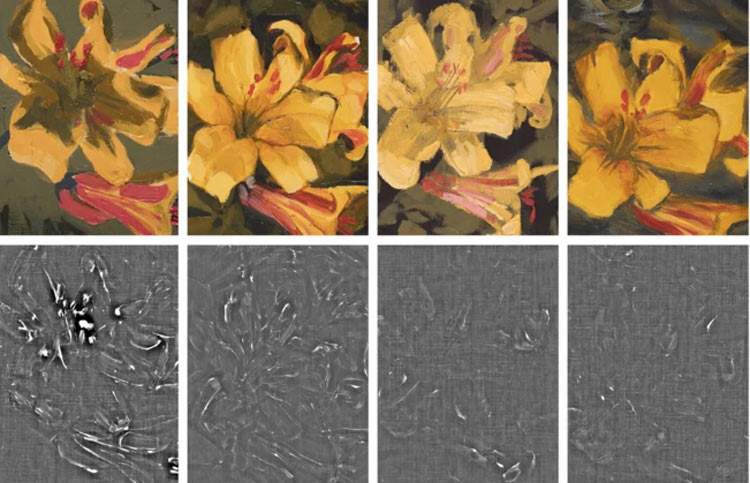Will technology put an end to doubts about undocumented works, enshrine the demise ofattributionism, and perhaps even put too many reckless critics out of business? It may be too early to tell, but in the meantime, there are those who are working on it: thus, a team of fourteen researchers from Case Western Reserve University in Cleveland, United States, has developed a system to recognize a painter’s hand and published the results in the scientific journal Heritage Science.
The system takes advantage of3-D imaging and artificial intelligence, and the experiment started at the Cleveland Institute of Arts, where researchers asked students to paint four identical yellow flowers (four water lilies, with the same materials and tools), treating them as if they were copies. The paintings made by the students were scanned through an instrument (the optical confocal chromatic profilometer) usually used for the surface analysis of different materials, after which the results obtained were used to create convolutional neural networks (CNN or ConvNet: this is a fundamental tool in machine learning or machine learning technologies) in order to determine the unique characteristics of the individual brush strokes, or, in other words, the hand of the artist. Indeed, the basis of the study is the idea that by studying the three-dimensional surface of works, unintended stylistic information can be detected and captured through optical profilometry.
The instrument was able to recognize artists with an accuracy ranging from 60 to 96 percent depending on the individual “pieces” of the painting on which the experiment was conducted. The scientists were surprised to see how the smallest samples, about the diameter of that of a bristle, were the key points for reliably distinguishing artists.
“Machine Learning (ML) analysis for works of art,” the paper states, “is a budding methodology aimed at advancing connoisseurship, the primary method for determining the attribution of a work of art, among other applications involving art. ML has been successfully applied to images of paintings for a variety of tasks, including detecting forgeries, classifying digital collections, and recognizing an artist’s style. While many of these studies have applied ML to high-resolution photographic images of paintings, in this study we used ML to analyze topographic data obtained from optical profilometry. In addition, advances in the resolution, speed, and availability of such profilometry measurements are developing, along with methods for big data that can handle the large data sets produced by these measurements. In paintings, surface topography reveals unintentional stylistic elements embedded in the surface of the painting that may include varnish deposition and drying, patterns in the brushstroke, physiological factors, and other aspects of the painting’s creation.”
One of the fields of application of this technology, the Case Western Reserve University researchers explain, could be the study of the workshops of great artists in order to understand how the collaborators of great painters such as El Greco, Rembrandt and Rubens worked, who were known to have had workshops where many artists were employed in order to meet the growing demands of the market. Connoisseurs, the researchers explain, “examine the visible stylistic elements of a composition, along with material elements, conditions and other clues about the manufacturing process to arrive at a historical understanding of the attribution of a work of art.” However, the study further states, “many of the specifics regarding workshop practice remain elusive. In the case of the workshops, artists sought to make a complete painting in a unique style, and this poses a challenge to the methods of the connoisseur. Moreover, the challenges of such attributions create conflicts when attribution is closely linked to the apparent value of objects in the art market. Therefore, unbiased and quantitative methods are needed to provide information on controversial attributions of workshop paintings.”
“This result,” the researchers write in the conclusions of their study, “suggests that our techniques are complementary to connoisseurship, which focuses on longer scales. Therefore, surface topography expands the tools for attribution, conservation, fake detection, and preservation of cultural heritage. In addition, we have found that profilometry data provide greater attribution accuracy than using photographs when the subject and color palettes of the training and test data are significantly different.” The difficulties encountered by the Case Western Reserve University researchers at the moment relate to the state of preservation of the paintings, which can alter the results, and the temporal distance involved in paintings done by real artists (different amounts of time can pass between one work and another, and the artist may not always paint the same way). There is confidence, however, for a method of analyzing paintings that may prove promising: it will not replace connoisseurship (and everyone obviously realizes this), but it could be a useful additional tool.
Pictured are flowers painted by Cleveland Institute of Arts students and their respective digital processing.
 |
| USA, researchers invent tool to... Attribute the works of artists |
Warning: the translation into English of the original Italian article was created using automatic tools. We undertake to review all articles, but we do not guarantee the total absence of inaccuracies in the translation due to the program. You can find the original by clicking on the ITA button. If you find any mistake,please contact us.